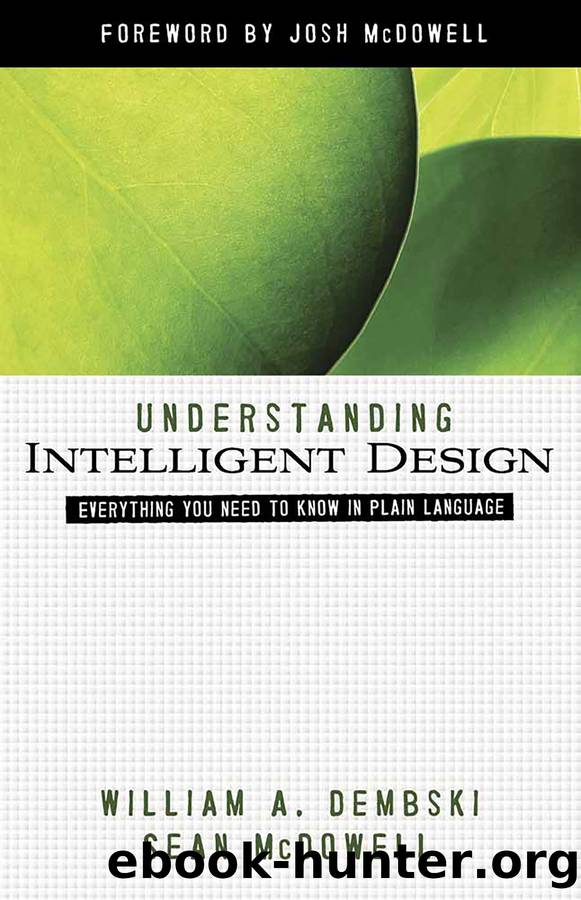Understanding Intelligent Design by William A. Dembski

Author:William A. Dembski
Language: eng
Format: epub
ISBN: 9780736982979
Publisher: Harvest House Publishers
Published: 2020-02-18T00:00:00+00:00
A Powerful Conclusion
In The Design Revolution, I (Bill) posed a question worth repeating here: âIs nature complete in the sense of possessing all the capacities needed to bring about the information-rich structures that we see in the world and especially in biology? Or are there informational aspects of the world that nature alone cannot bridge but that require the guidance of an intelligence?â12 In the context of biology, this question asks whether nature has the power within itself to produce life, and if not, what else is needed. Nature certainly provides the raw materials for life. But thatâs a different question. The question we are exploring is whether those raw materials alone contain the capacity to produce life.
To answer this question, it is important not to be fooled by the sheer commonness of life all around us. At one time, no single-celled or multicelled organisms existed on earth. Before that, no earth, sun, moon, or planets existed. And if modern physicists are right, there was a time before that when no stars or galaxies existed but only fundamental particles (like quarks) packed densely at inconceivably hot temperatures right after the Big Bang. Question: Was all the potential for complex living organisms, like us, present at this earliest moment in time? Certainly stars, planets, and complex life developed from this early state, but this doesnât tell us whether nature alone had sufficient creative power to produce us apart from design.
According to philosopher Holmes Rolston, humans are not invisibly present in single-celled organisms in the same way that an oak tree is secretly present in an acorn. An acorn unfolds naturally into an oak tree in a law-like pattern. But the same cannot be said for the Darwinian story that begins with the emergence of single-celled organisms and results in human beings. In no sense are humans or even simple multicelled organisms latent in single-celled organisms (as an oak is in an acorn), much less in the chemicals that make up our bodies. For Rolston, to claim that life is somehow lurking in nonliving chemicals, or that complex biological systems are already present and lurking in simple biological systems, is an âact of speculative faith.â13
For Darwinists merely to assert that nature has such powers is not enough. They must also back it up. Somehow, from inorganic matter on the early lifeless earth, the first simple life form emerged. But even the simplest life form is exceedingly complex, needing several hundred genes in just the right combination to function properly. As we will see, even the most basic living organisms are full of specified complexity. But how did that happen? What caused it?
According to design proponents, the design of nature could not have arisen apart from intelligence. Nature exhibits design that nature alone is unable to account for. To attribute to nature the power to generate specified complexity in biological systems is like saying Scrabble pieces have the power to arrange themselves into meaningful sentences. The absurdity is apparent in the one case. It is quickly becoming apparent also in the other.
Download
This site does not store any files on its server. We only index and link to content provided by other sites. Please contact the content providers to delete copyright contents if any and email us, we'll remove relevant links or contents immediately.
Signature in the Cell: DNA and the Evidence for Intelligent Design by Stephen C. Meyer(3055)
Real Sex by Lauren F. Winner(2950)
The Secret Power of Speaking God's Word by Joyce Meyer(2925)
The Holy Spirit by Billy Graham(2880)
The Gnostic Gospels by Pagels Elaine(2459)
Jesus by Paul Johnson(2294)
Devil, The by Almond Philip C(2266)
23:27 by H. L. Roberts(2186)
The Nativity by Geza Vermes(2165)
Chosen by God by R. C. Sproul(2113)
All Things New by John Eldredge(2092)
Angels of God: The Bible, the Church and the Heavenly Hosts by Mike Aquilina(1916)
The Return of the Gods by Erich von Daniken(1886)
Angels by Billy Graham(1876)
Knowing God by J.I. Packer(1793)
Jesus of Nazareth by Joseph Ratzinger(1754)
Evidence of the Afterlife by Jeffrey Long(1734)
The Gnostic Gospel of St. Thomas by Tau Malachi(1726)
How To Be Born Again by Billy Graham(1718)
